
October is really a busy and fruitful month for leading solids control manufacturer – GN Solids Control. After big quantity oil rig mud solids control equipment to Russia, and advanced PLC smart control drilling cuttings management equipment to SINOPEC. This week, a big batch of solids control equipment will be dispatched to a Ukraine client soon.
This project is a tender for solids control equipment on totally 16 sets oil rig in Ukraine. They are used to replace the old equipment in their rigs. The whole project will be shipped by 4 batches. This is the second batch of shipment. The whole project including follow equipment: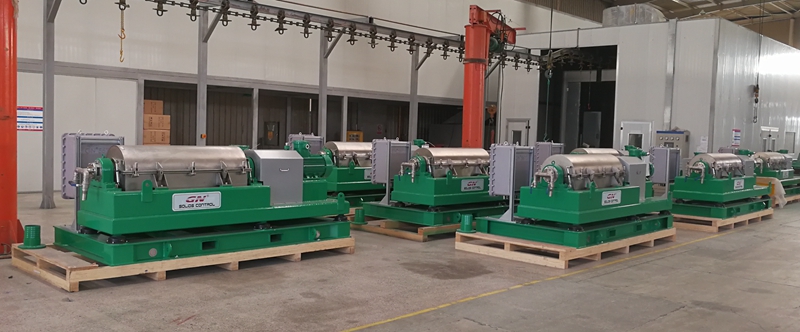
1) Over 30 sets decanter centrifuge for barite recovery and fine solids separation
2) Over 30 sets 4-panel solids control shale shaker
3) Over 30 sets mud cleaner
4) Many sets vacuum degasser
So many companies followed the tender, Why client finally choose GN Solids Control?
Firstly, GN Solids Control is the No. 1 solids control manufacturer in China. Clients are expressed with GN advanced equipment design and excellent service team. 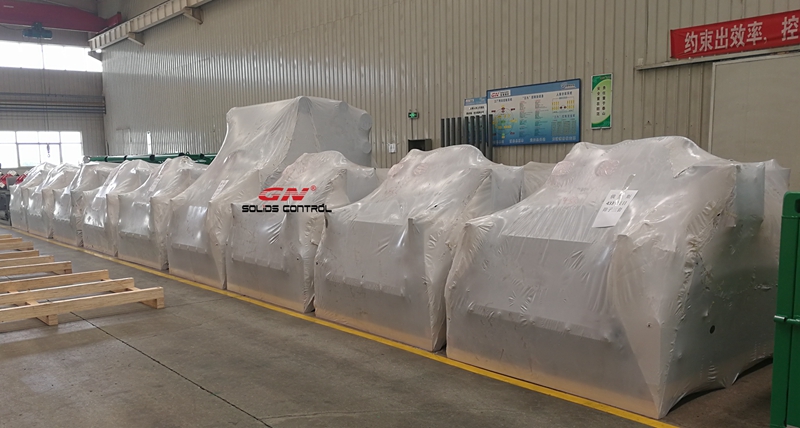
Secondly, unlike other solids control manufacturers, GN Solids Control makes all solids control equipment, including replacement shaker screens by themselves in their own facility. While most other companies, they only make the simple equipment shale shaker, mud cleaner, etc… GN Solids Control owns the full line processing machine for centrifuge production. They can control the quality and cost better than others.
Thirdly, GN Solids Control keeps improving. GN owns its own research and development department for new equipment. GN Solids Control develops over 10 patents was authorized by government as the high-tech company. GN Solids Control can pay less 10% duty than others. We can give clients better price with high standard quality.
And finally, delivery time is very importance for the clients. As GN Solids Control have stable and growing sales on all the major equipment, in order to support clients in a shorter delivery, GN Solids Control keep stock for most equipment. It only takes 1 ~ 3 weeks for suitable motors and electrical control panels. For other companies, it will takes 80 ~ 90 days for manufacturing, while GN Solids Control can delivery all in short time with reliable quality.
- Details
-
Published: 22 October 2017
GN Solids Control is a worldwide famous and reputable brand for liquid / solids separation, like drilling mud solids control, oily sludge separation, drilling waste and industry waste management. As we all know, customized solution request a much higher ability of the suppliers. And the cost will be much higher than the standard manufacturing solution. In order to meet clients’ request suits for jobsite condition, GN Solids Control do offer customized solutions per clients’ reasonable request.
Recently, GN Solids Control offers 3 sets mud gas separator (poor boy degasser), and 10 sets drill waste collection containers SINOPEC. It is not normal type mud gas separator, it is PLC smart control waste collection container, it suits for long distance smart control. 
The features of the PLC smart control waste collection container:
1) The waste collection container is sealing well, it can avoid leakage during shipment to protect the environment. The good sealing can also prevent volatile gases which are harmful to human body.
2) The waste collection container can be open and closed automatically. They do not need operators stand by the waste collection container. It saves much on man powers. It suits for areas with expensive man power cost.
3) Furthermore, the waste collection containers are powered by motor, control by PLC smart system and monitor by sensors. They do not need people to watch it, open or close it. It can be controlled by far away control center through wireless net. The waste collection container is an idea choice for some hazardous areas or the waste material is harmful to human beings.
In normal conditions, the operators can stay at safety area. The PLC smart control system and sensor monitoring system will open and close the waste collect box automatically per the preset program. The wireless control make it very flexible for operation. Within the limited areas, people can control it in any place.
- Details
-
Published: 15 October 2017
GN Solids Control is only focusing on mud solids control equipment manufacturing, drilling waste management equipment manufacturing, and high quality replacement screens. GN Solids Control welcome clients to contact us for inquire inquires for questions for oil field waste management.
Recently, 3 sets solids control equipment for Russia are finished fabrication for delivery.This is a repeated order from the client. The system was designed by GN team,have good efficiency.
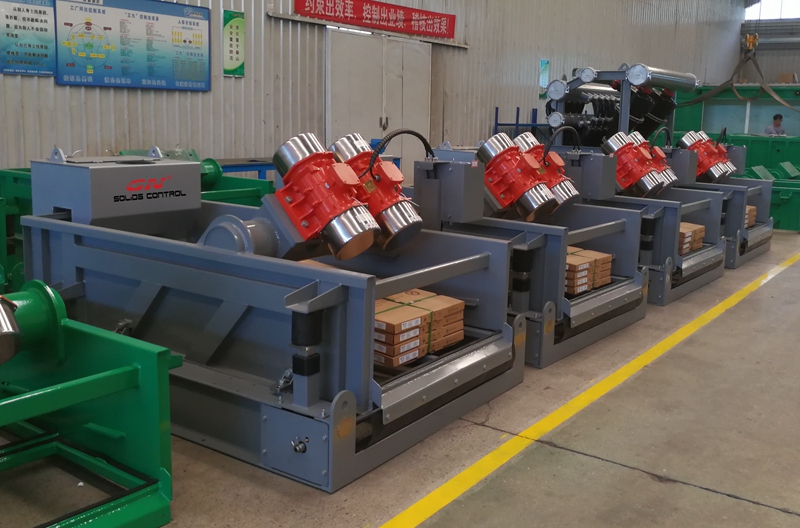
The 3 full sets oil rig mud treatment equipment are including following:
1) 9 ea shaler shaker:
The 9 shale shakers are for 3 oil rigs. Each rig is equipped with 3 shaker sets. It is linear motion single deck shale shaker. Each shaker is with 4 screen panels. The screen panels are sealed with GN patent design sealing rubber. The high quality replacement screens are made from composite material for longer lifetime and reliable performance.
2) 3 ea mud cleaner
The mud cleaner is the combination of linear motion shale shaker, desander, and desilter.
3) 6 ea decanter centrifuge for barite recovery and fine solids separation
It is GN premium 14inch decanter centrifuge for international market.
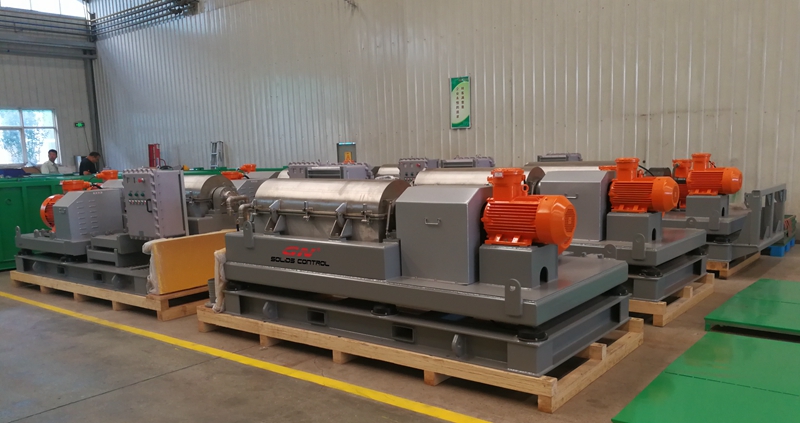
4) 3 sets mud mixing system and many pumps
It is a repeat order from the same client from Russia. Before they use GN equipment, they only used U.S made equipment. They sent engineering team to China to visit different suppliers in China. But finally they only follow GN for equipment purchasing. They believe that GN centrifuges has enough motor powers to produce better cut points with less costs of maintenance. They are for sure that GN Solids Control has built a good experience in producing solids control equipment which solves all the issues with oil filed centrifuges as the structure and designs have better performance comparing to other company’s equipment.
GN specified design for decanter centrifuge shows less maintenance required for centrifuges, especially for remote areas where equipment can function with steady performance for long time. GN is your best choice for mud solids control and drilling waste management.
- Details
-
Published: 29 September 2017
As a drilling mud decanter centrifuge manufacturer, GN Solids Control has developed a series of big bowl decanter centrifuge for tunnel boring machine slurry treatment. The most popular decanter centrifuges for TBM projects are as following:
1)GNLW553C-VFD Decanter Centrifuge
The GNLW553C decanter centrifuge is designed with bowl size of 22inch diameter by 71 inch length. The hydraulic capacity for water is up to 500GPM. This centrifuge is designed for small Tunnel Boring Project. It can be used with flocculation system for dewatering or mechanical separation for TBM Slurry.
2)GNLW764A Decanter Centrifuge
The GNLW764A decanter centrifuge is large bowl centrifuge is designed with bowl size 30inch diameter by 132 inch length. It’s hydraulic capacity for water is up to 1000GPM. This centrifuge is designed for big Tunnel Boring Project.
Features of GN Big Bowl Decanter Centrifuge for TBM Slurry Treatment
1)Duplex Stainless Steel bowl made from Centrifugal casting.
2)All along the screw inside the bowl is protected by Tungsten Carbide tiles.
3)The Solids Discharge port on the bowl and the Mud distribution port on the Auger is protected by Tungsten Carbide inserts.
4)The bearing is SKF premium bearings for longer and stable operation.
5)The VFD and PLC control system with HMI screen design is for user friendly and smart control.
The typical process of TBM Slurry Separation
The TBM slurry feeds to Coarse mesh primary shale shaker for first phase separation. After that the overflow will be pumped to big desander cones for sanding removal. The third phase separation is by a group of desilters for silt separation. Normally below the desander and desilter the underneath shaker is for drying the solids. The decanter centrifuge is used to remove fine solids. The flocculation system is to offer chemical enhanced technology to give clean water for reuse.
- Details
-
Published: 19 September 2017
GN Solids Control makes big bowl decanter centrifuge for building construction field for dewatering. As the building construction is mostly took in the city, where has strict request to reduce the waste and control the pollution. GN Solids Control offers complete solution on construction field waste water treatment. 
Some days ago, another set waste water treatment and recovery system was dispatch to a client in USA. This is not the first system the client bought from GN Solids Control. The client bought some waste water recovery systems from GN Solids Control Houston company: GN Solids America. They used the systems in USA for some projects. They are happy with the performance. And GN waste water treatment and recovery system helps them save much money on environmental protection. They did not need to cost much money to hold and transfer the waste mud and waste water generated from their construction activities, and then pay money to other waste treatment money for purification. Now they can do all the jobsite on site. They can used the recovered water for their construction drilling field. They can save money, save people and save time for their projects.
The construction waste water treatment system is including below processing equipment:
1) The first separation is by a coarse mining shale shaker to remove rocks and big size sands.
2) A solids control shale shaker will be used as the second stage separation to further remove sands and silts.
3) A desilter is used after solids control shale shaker to reduce the silt content.
4) After the desilter separation, there will be not big size solids in the liquid. Big bowl decanter centrifuge and domical dosing system will be used together to remove the ultrafine solids after desilter.
After all above separation, the solids discharged is dry and easy for movement or further treatment. The water is reach the standard for industry recycling.
- Details
-
Published: 08 September 2017
GN Solids Control is the No. 1 brand in China for direct importing of compact mud recycling system for different applications, like HDD, water well drilling, piling, micro tunneling, or other no-dig underground constructions.
Why GN Solids Control mud recycling system is hot sold and welcomed by international customers? Below are some of the reasons:
1) GN mud system capacity and shale shaker capacity is defined in real drilling mud condition, like the system capacity max. 120m3/h or 240m3/h, it means the shale shaker on the mud recycling system can handle max. 120m3 or 240m3 drilling mud with API 40 screen (400microns) for 1.2g/cm2 mud density and 40s mud viscosity.
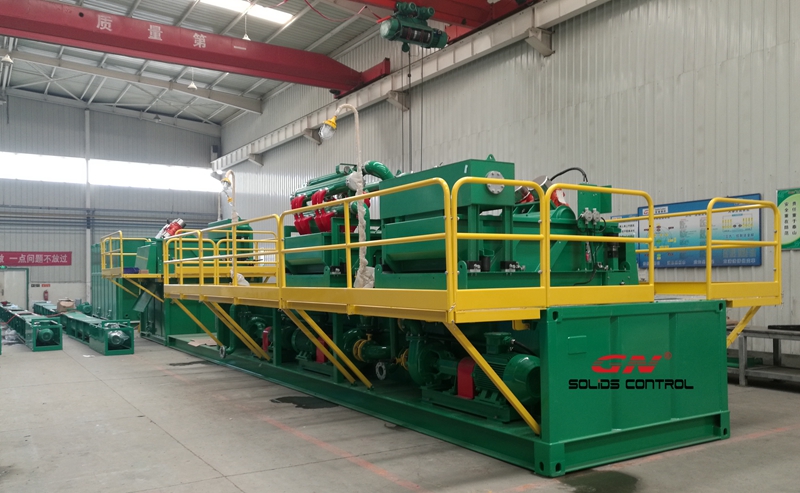
There are many other brand, they write down a huge system handling capacity, but their handling capacity is under big opening steel screen for max. water flow. It has no meaning for clients to know the real mud capacity.
2) GN Solids Control utilizes high G force oil field shale shaker to treat drilling mud. The G force is up to7.5G, and it is adjustable. Furthermore, GN Solids Control offers high quality composite material or PU material replacement screens to suit for different mud condition. The composite material screen and PU material screen can last a much longer time than the traditional metal frame or steel screens. For other brand recycling system, maybe their shaker area is bigger, but their G force is small. It is only 4G or 5G. For the same screen area, its handle capacity is much smaller than GN Solids Control high G force shale shaker. So GN Solids Control shale shaker can handle a bigger mud flow with a smaller shaker screen area. It is more compact in design.
3) For the similar configuration, GN Solids Control price should be very competetive. GN Solids Control are the original mud system manufacturer. All equipment inside the system are made by GN. There are many companies, especially the rig companies, they do not make separation equipment, they buy equipment from others, and they only build the tank.
4) Per our understanding on some U.S mud system brands, their system price is not higher, but their system is too much simple. They care too much on compact design and ignore the performance. But GN Solids Control ensures the performance first, based on the performance; GN Solids Control tries to make it more compact. That is why many customers choose us after compare with U.S and German brand.
- Details
-
Published: 04 September 2017
